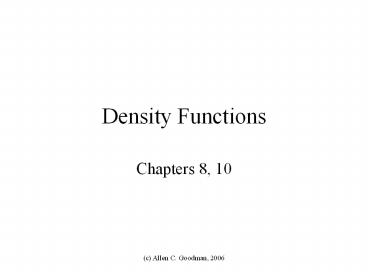Density Functions - PowerPoint PPT Presentation
1 / 18
Title:
Density Functions
Description:
We saw that the competitive bidding for land yielded rent curves that looked like this: ... International Perspective. From. Alain Bertaud, 2003 ... – PowerPoint PPT presentation
Number of Views:45
Avg rating:3.0/5.0
Title: Density Functions
1
Density Functions
- Chapters 8, 10
2
Rent Functions
- We saw that the competitive bidding for land
yielded rent curves that looked like this
Rent
Distance
3
Impacts of Decreasing Rent
- We substitute capital for land, where land rent
is high ? vertical city. - We substitute land for capital, where land rent
is low ? horizontal city. - What happens over time?
4
Over Time
- Agt Remember ?p -t/h. Over time, out-of-pocket
t ?, making the numerator small. Why? - However, as income ?, valuation of time may rise,
so technically, travel costs could go either way. - See time_costs.xls
5
Over Time
- Remember ?p -t/h
- Over time, income ? making housing ?, making the
denominator large. Why? - What happens to rent function?
6
Over Time
- Consumers bids (per mile) tend to get shallower.
Locating near the center isnt important. Lots
of urban analysts call this the traditional
model of decentralization. - How do we measure it?
7
Density
Do
- Density Density at the center, multiplied by a
decaying factor. - D (u) Do exp (-?u), or
- D (u) Do e- ?u
- The larger the value of ?, the steeper the
density function, the more centralized.
Density
Distance
8
Density
- Over time, we would expect that urban areas
become less dense, so the function becomes
flatter. - Theres a whole host of empirical work that bears
this out for population, housing, employment.
Early
Density
Later
Distance
9
Decentralization
- Clearly, the population has decentralized.
Percentages of populations in central cities have
fallen continuously for as long as we can
measure. - This has happened for both employment and for
residences.
10
McMillen Finds
McMillen, Daniel P., Polycentric urban
structure The case of Milwaukee, Federal
Reserve Bank of Chicago, Economic Perspectives,
15-27
11
Transportation Changes
Land rent
- Key changes -- Ability to move goods on roads.
Intracity and intercity trucks. - You can move goods out from central shipping
point. - You can ship directly without going to center
Bid function w/ horse-drawn wagon
Bid function w/ truck
Residential
Distance
12
So, Why Suburbanization?
- Increase in real income
- Decrease in commuting cost
- Central-city problems race, crime, taxes,
education - Following firms to the suburbs
- Public policy
13
Public Policy?
- Subsidies for home-ownership
- Commuting externalities
- Fragmented system of local government has
suburbs competing with central cities. - Highway construction
14
Gentrification?
- Coming back to the city?
- Who does it?
- Wealthy, young, highly educated
- Relatively high commuting costs
- Relatively low demands for housing and land
- Few children
- Most move in from elsewhere within city
- Many move out when children get older
15
Subcenters Los Angeles
- Come from agglomeration economies.
- Important for employment and commuting.
- CBD is still largest.
16
Density with Subcenters
Density
- City and metropolitan area may have bumps.
Distance
17
Figure 1 Three dimensional views of
population distributions in 7 cities represented
at the same scale
International Perspective From Alain Bertaud,
2003
18
Built-up Densities around the world (figure 2)
640 acres/sq.mile 259 hectares/ sm
Bombay Approx 101,000/sq.mile































